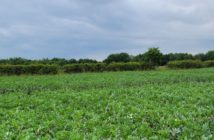Sclerotinia infection risk forecasts will soon be available from the AHDB website to help growers decide if, when and where to spray.
Based on a simple traffic light system, the forecasts show the potential infection risk level at 15 oilseed rape monitoring sites. The information can be used, alongside in-field data, to assist with the targeting of sprays.
Automated spore trapping, explored in a connected research project, is also opening up exciting opportunities for the production of real-time spore pressure data for key diseases, including sclerotinia.
About sclerotinia and the forecasts
In spring, sclerotinia sclerotia germinate in the soil and produce fruiting bodies which release airborne spores. Some of these spores are carried onto petals which fall and stick to leaves or leaf axils, especially if there is light rain.
Caroline Young, who works on the forecasts at ADAS, said: “Whether a crop is at risk from infection depends on multiple factors.
“Fungal inoculum pressure during flowering is particularly important. In fact, our research shows that if petal tests come back clean, then the need to spray against sclerotinia is radically reduced.
“If petals carry inoculum, then weather conditions become critical. Our weather model triggers an infection alert when relative humidity is greater than 80 per cent for more than 23 hours and temperatures are at, or above, seven degrees C.”
The weather-based forecasts, combined with inoculum results, help show if crops located at the monitored sites could benefit from an initial treatment with a protectant fungicide (which typically offer three weeks’ protection) and a follow-up spray.
Spore trapping
Air samplers are also located at five of the monitoring sites to provide weekly information on the amount of sclerotinia spores in the air.
At present, samples are sent to laboratories for analysis but a connected research project, led by Rothamsted Research, looks to automate this process for sclerotinia, in addition to fusarium, yellow rust and septoria in wheat.
Jon West, who leads the research at Rothamsted Research, said: “Our prototype automated spore trap looks promising. We’ve made the sampling efficiency 20 times better and developed the technology so the unit can produce subsamples and carry out reactions to quantify the level of spores.
“It’s not a question of whether such devices get used in the future, it’s a question of when. The first units could cost several thousand pounds each but, if placed at strategic locations, they could act as a network to produce real-time information on disease pressure.”
It is the third year running that AHDB has published information on sclerotinia infection risk. The weekly risk reports, which are likely to start as early as next week, can be accessed at cereals.ahdb.org.uk/sclerotinia




